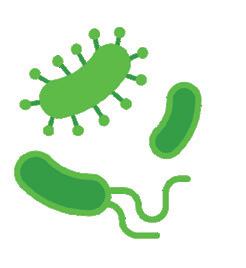
4 minute read
Kitchen Safety: Food POISONING PREVENTION TIPS
from July 2023
by VIP Magazine
Have you ever had food poisoning? If you have, you know how miserable it can be! The good news is food poisoning, also called foodborne illness, is highly preventable in your own kitchen. Each year, one in six or 48 million Americans get sick from food poisoning, with 138,000 people hospitalized, and 3,000 deaths. September is Food Safety Month and a great time to review ways to keep your kitchen safe from growing the tiny bacteria “critters” that can make us sick!
Often people mistake a stomach flu or bug, also called viral gastroenteritis, for food poisoning. Stomach flu such as the norovirus is a result of an infective virus caused by being in close contact to others who have it. Foodborne illness comes from bacteria on food caused by improper handling, storage, or preparation. It is a challenge to tell the difference between the two since the symptoms are almost identical, including stomach cramping, fever, nausea, vomiting, and diarrhea. Symptoms from food poisoning can appear in four hours and up to a week after ingesting the contaminated food, and symptoms can last anywhere from 24 hours to a week. Most people can tell the difference if a food tastes “off” and symptoms come on quickly or if many people get sick from the same food source.
Advertisement


Proper kitchen safety can keep food almost completely safe from the bacteria that causes foodborne illness. You can prevent foodborne illness in your kitchen by following the four basic steps of food safety: clean, separate, cook, and chill.
Clean
• Keep your hands clean by washing often during meal prep using warm soapy water (anti-bacterial soap is not necessary!) and scrubbing hands, fingers, and under nails for 20 seconds, which is the time it takes to sing the happy birthday song twice.
• How often do you need to wash your hands? Do so before and after each part of meal prep and especially after prepping any kind of meat, poultry, seafood, or eggs. If interruptions happen during meal prep, also wash your hands after using the bathroom or helping someone use the bathroom, after feeding or caring for a loved one, petting, feeding, or cleaning up after a pet, and after sneezing, coughing, or blowing your nose.
• Make sure to wash surfaces, containers, and utensils with warm soapy water after each use, and sanitize surfaces with a commercial spray (follow directions) or add one teaspoon of bleach in one quart (32 ounces) of water in a spray bottle. Spray and leave on for 10 minutes before wiping to be effective. Make sure all surfaces are dry before using.
• Rinse and scrub fruits and vegetables well, clean the lids on canned goods before opening, and machine wash dish cloths often in hot water.
• Avoid cross-contamination (moving germs to other areas) which occurs when you don’t properly rinse or wash meat, poultry, seafood, or egg products.
Kitty Finklea, RDN, LDN, AFAA-CPT, is a registered dietitian nutritionist, certified personal trainer, and health writer for HopeHealth. Contact her at kfinklea@hope-health.org

SEPARATE (KEEP APART)
• Risk of cross-contamination is highest in raw animal proteins so keep meat, poultry, seafood, and eggs separate in the grocery cart and bags and in the fridge or freezer.
• Use a separate cutting board or plate for raw animal products.
• Keep your refrigerator and freezer clean from drips or spills and avoid overcrowding food to encourage circulation of air.
Cook
• The danger zone for bacterial growth is between 40-140 degrees Fahrenheit. Heat kills germs making it important to cook meat, poultry, and seafood to the proper temperatures:
Beef, Pork, or Lamb
Fish
Ground Beef, Pork or Lamb
Turkey, Chicken, Duck
145 degrees Fahrenheit
145 degrees Fahrenheit
160 degrees Fahrenheit
165 degrees Fahrenheit
• Check foodsafety.gov for guidelines for other foods.
• It is recommended to use a food thermometer to check the food temperatures to make sure there is no doubt that it’s cooked properly!
Chill
• Place perishable foods such as meat, poultry, seafood, eggs, produce, or other perishable items along with leftovers in the fridge or freezer right away.
• Follow the two-hour rule – never allow perishable food to sit out at room temperature for more than two hours. If the temperature is over 90 degrees Fahrenheit, such as at an outdoor event, food should be refrigerated no later than one hour after buying or serving.
• Never thaw foods on the counter or in a sink full of water. Instead move frozen meats from freezer to the refrigerator, defrost in the microwave, or under cold running water.
• Marinate foods in the refrigerator and do not reuse marinades on raw or cooked meats unless they are brought to a boil first.
• Check to make sure the refrigerator temperature is at or below 40 degrees Fahrenheit and the freezer is at or below 0 degrees Fahrenheit.
Other Important Tips
• Check storage directions on labels. Many items other than meats, vegetables, and dairy products need to be kept cold. If you've neglected to properly refrigerate something, throw it out. It’s not worth it!

• Once a week, check expiration and "use by" dates, and throw out foods if the date has passed. If in doubt, throw it out!
• Replace excessively worn cutting boards (including plastic, non-porous acrylic, and wooden boards). Bacteria can grow in the hard-to-clean grooves and cracks.
• If soap and water aren't available, use alcohol-based wipes or gel formulas to sanitize hands.
• Be aware that food can make you very sick even when it doesn't look, smell, or taste spoiled. That's because foodborne illnesses are caused by infective bacteria, which are different from the spoilage bacteria that make foods "go bad." Many infective organisms are present in raw or undercooked meat, poultry, seafood, milk, and eggs, and on fruits and vegetables. Rinsing and scrubbing fruits and veggies well and keeping foods properly chilled will slow the growth of bacteria and proper cooking can help destroy them.
• If you think you have food poisoning, contact your health care provider immediately to seek care. Save the food package, can, carton, or food item from a food seller. Report the problem by calling USDA at 1-888-674-6854 if you think the illness was caused by meat, poultry, or eggs. Call FDA at 1-866-300-4374 for all other foods. Contact your local health department if you think you got sick from food you ate in a restaurant or from another food seller.
Take the time and adopt the steps outlined above to help keep your food safe!
843.667.9414










